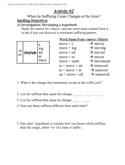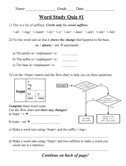Visit the website of local teacher, Sean Lonergan to see the kind of learning that happens when Grade five students work with Real Spelling.
Sean is working with WordWorks by maintaining a Word Detectives blog that teachers and students from around the world use to ask and answer fascinating spelling questions. Check it out!





-
Click the images above for a pdf of lessons adapted from Real Spelling that can be used to introduce children to how word structure works.
-
Click this link <Notes on Activities 1, 2 and 3.pdf> for a short note on some underlying goals, and some details that are key to making these activities effective.
-
Lesson 2 is a particularly good example of engaging students in word study by letting them become “Word Detectives” who discover key patterns that explain English Spelling.
-
Examples of WordWorks lessons built from these tools
-
Examples of “Spelling System Tests”, not “Spelling Tests”
-
These are tests of word structure knowledge, not tests of the spelling of the specific words used. With appropriate instruction grade four and five students are able to show deeper understanding on these quizzes than most adults.
-
See if you can answer the challenge questions. Email us if you what to test your theory.


-
Children enjoy stories about the history of words. These stories also show spelling and meaning connections between many words (e.g., moon, Monday and month).
-
-
-
Etymology is also used to teach about connections between words with similar meanings. This image is from a lesson showing why the letter <w> is used in the word <two>.

-
This phonological matrix builds words that use the three letter grapheme <igh> to represent the long vowel sound <i> (the phoneme /aɪ/).
-
Etymological Instruction

-
Phonological Instruction
-
We teach the patterns that explain connections between sound in the words we speak, and the letters or letter combinations that are used to represent those sounds.


-
Click the buttons below to jump to a short clip from the Real Spelling web site that explains these teaching tools and linguistic terms that are central to our instruction.
-
Morphological Instruction
-
We teach how bases, prefixes and suffixes combine to represent the meaning of words.








The chart below shows links between themes in the Real Spelling Tool Box.









